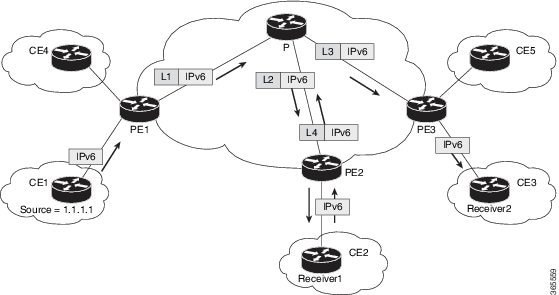The sample output in this section displays the VRF mroute table on PE-West before the high-bandwidth source exceeds the threshold.
At this point there are two streams, representing each of the two VPN sources at PE-West, on a single MP2MP LSP (System ID
D8000000). The LSP represents the default MDT accessed via LSP-VIF interface 0.
PE-West# show ip mroute vrf VRF verbose
.
.
.
(10.5.200.2, 238.1.200.1), 00:00:25/00:03:29, flags: sT
Incoming interface: Serial6/0, RPF nbr 192.168.10.6
Outgoing interface list:
Lspvif0, LSM MDT: D8000000 (default),Forward/Sparse-Dense,
.
.
.
(10.5.200.3, 238.1.200.2), 00:11:14/00:02:48, flags: sT
Incoming interface: Serial6/0, RPF nbr 192.168.10.6
Outgoing interface list:
Lspvif0, LSM MDT: D8000000 (default),Forward/Sparse-Dense,
.
.
.
The sample output in this section displays the output after the source transmission exceeds the threshold. PE-West sends an
MDT Join TLV message to signal the creation of a data MDT. In this case, the data MDT number is 1, therefore PE-East will
send a label mapping message back to PE-West with a FEC TLV containing root=PE-West, Opaque value=(mdt vpn-id 1). The System
ID is now changed to 4E000003 signaling a different LSP; however, the LSP-VIF is still LSP-VIF interface 0. The (S, G) entry
also has the “y” flag set indicating this stream has switched to a data MDT.
PE-West# show ip mroute vrf VRF 10.5.200.3 238.1.200.2 verbose
.
.
.
(10.5.200.3, 238.1.200.2), 00:00:08/00:03:27, flags: sTy
Incoming interface: Serial6/0, RPF nbr 192.168.10.6
MDT TX nr: 1 LSM-ID 4E000003
Outgoing interface list:
Lspvif0, LSM MDT: 4E000003 (data) Forward/Sparse-Dense,








 Feedback
Feedback